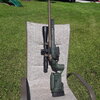Nature Boy
Member
- Joined
- Apr 21, 2015
- Messages
- 8,227
Or... I’ll just throw it in the river...
Since the rings and base were/are tight, I’m betting on the scope, but frustrated that it is not more obvious. Really hoping it’s that simple, not excited about tearing off this barrel when it’s only halfway done.
I don’t suppose you have a fixed power scope?
If so, that’s a good way to nail down the scope as the issue.
These guys have a device that allows you to check POI shift on scopes if you have a fixed power scope
https://fieldandcaveoutfitters.com/products/f-c-s-2018-picatinny-scope-checker-upper-mounts
Having said that, a half mil shift due to the scope should be apparent. That’s what has me scratching my head











